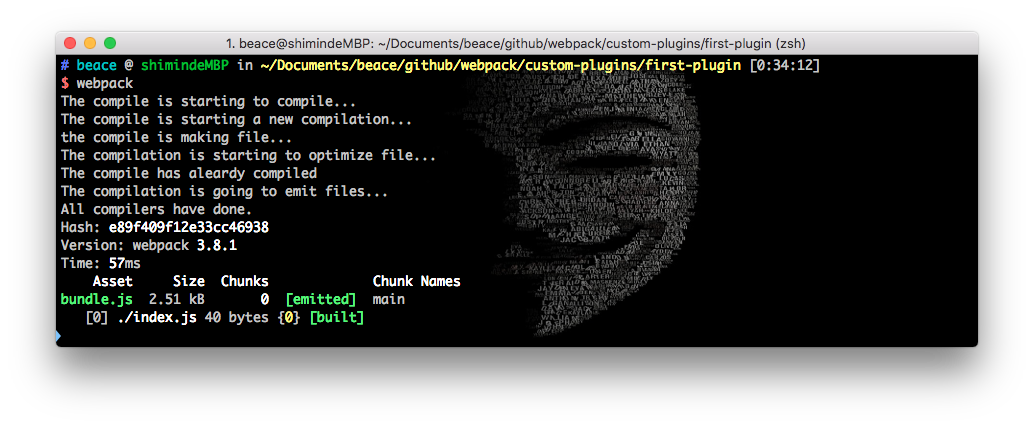引子
想要了解webpack plugin如何编写,首先要了解其应用场景和作用。
可以先浏览这三篇文章
除此之外,在这里我和webpack loader进行了简单的对比。
plugin & loader
plugin
顾名思义,webpack plugin是作为webpack的一个插件机制存在,将webpack提供的处理方法暴露给第三方(开发者)来开发。在整个项目架构中,往往起宏观上的作用。例如HtmlWebpackPlugin,修改一些文件,inject一些用户的资源,这些资源往往是经过loader处理过的资源,比如jsx文件,css文件。
loader
而loader用于对开发者源代码的转换,功能而言,跟webpack本身并没有强耦合的关系。例如,强大的babel-loader可以使用浏览器暂不支持的JavaScript语法(糖),css-loader和styles-loader用来处理你的css。
总之,Loader的这些工作不需要开发者去干涉,只需相应配置全权交个loader去处理。而plugin往往需要用户先预备好已经有的资源,再去对资源进行宏观上的操作,并不会在内容细节上处理。
场景的明确
我们需要明确一些plugin场景来进行实际开发的模拟。比如,抽离公共模块(CommonsChunkPlugin),控制模块的输出方式,或者输出内容(这里可能体现比较直观的是UglifyJsPlugin),复制一些为经过webpack处理的静态文件(copyWebpackPlugin)。
Compiler and Compilation
在了解生命周期之前,必须要了解Compiler and Compilation两个概念,我通常会翻译成编译器和编译集合。
Compiler(编译器)
翻译为编译器,是因为往往编译器在开发者的眼中是整个源代码所处的编译环境(预设环境),是一个静态场景。webpack通过Compiler提供了webpack配置内容的所有配置项和插件相关的调用函数,在这里,你可以随意获得你想要的某个配置,并且根据相应的配置书写相应的plugin代码逻辑。下面展示了compiler中用到的一些生命周期和有关webpack配置的代码。
_plugins: { 'before-run': [ [Function] ], done: [ [Function] ] },
options:
{ entry: './index.js',
output:
{ path: '/Users/beace/Documents/beace/github/webpack/custom-plugins/first-plugin',
filename: 'bundle.js',
chunkFilename: '[id].bundle.js',
library: '',
hotUpdateFunction: 'webpackHotUpdate',
jsonpFunction: 'webpackJsonp',
libraryTarget: 'var',
sourceMapFilename: '[file].map[query]',
hotUpdateChunkFilename: '[id].[hash].hot-update.js',
hotUpdateMainFilename: '[hash].hot-update.json',
crossOriginLoading: false,
chunkLoadTimeout: 120000,
hashFunction: 'md5',
hashDigest: 'hex',
hashDigestLength: 20,
devtoolLineToLine: false,
strictModuleExceptionHandling: false },
plugins: [ HelloWorldPlugin {}, MyPlugin {} ],
context: '/Users/beace/Documents/beace/github/webpack/custom-plugins/first-plugin',
devtool: false,
cache: true,
target: 'web',
module:
{ unknownContextRequest: '.',
unknownContextRegExp: false,
unknownContextRecursive: true,
unknownContextCritical: true,
exprContextRequest: '.',
exprContextRegExp: false,
exprContextRecursive: true,
exprContextCritical: true,
wrappedContextRegExp: /.*/,
wrappedContextRecursive: true,
wrappedContextCritical: false,
strictExportPresence: false,
strictThisContextOnImports: false,
unsafeCache: true },
node:
{ console: false,
process: true,
global: true,
Buffer: true,
setImmediate: true,
__filename: 'mock',
__dirname: 'mock' },
performance: { maxAssetSize: 250000, maxEntrypointSize: 250000, hints: false },
resolve:
{ unsafeCache: true,
modules: [Array],
extensions: [Array],
mainFiles: [Array],
aliasFields: [Array],
mainFields: [Array],
cacheWithContext: false },
resolveLoader:
{ unsafeCache: true,
mainFields: [Array],
extensions: [Array],
mainFiles: [Array],
cacheWithContext: false } },
context: '/Users/beace/Documents/beace/github/webpack/custom-plugins/first-plugin',
}Compilation(编译集合)
Compilation虽然继承自Compiler,但是对于本身作用来讲,因为他包含了chunks,modules,cache,assets,是动态的资源集合。动态的原因是,在某个编译阶段,产生的编译资源是不相同的。
编译会显示有关模块资源,编译资源,更改的文件以及监视的依赖项当前状态的信息。编译还提供了许多插件可以选择执行自定义操作的回调点。
每一个版本执行的编辑逻辑(开发者),决定了上述特点。下面选取了部分关于chunks和assets中的内容
chunks:
[ Chunk {
id: 0,
ids: [Array],
debugId: 1000,
name: 'main',
_modules: [SortableSet],
entrypoints: [Array],
chunks: [],
parents: [],
blocks: [],
origins: [Array],
files: [Array],
rendered: true,
entryModule: [NormalModule],
hash: 'bfe5f97a4642c50a5286f6a28486186a',
renderedHash: 'bfe5f97a4642c50a5286' } ],
{ 'bundle.js':
CachedSource {
_source: ConcatSource { children: [Array] },
_cachedSource: undefined,
_cachedSize: undefined,
_cachedMaps: {},
node: [Function],
listMap: [Function] } }生命周期
简历一个简单的项目
通过以下简单的配置,我将一个index.js简单的进行webpack打包,输出bundle.js。并在根目录下创建my-plugin.js文件,作为即将开发的插件。代码如下。
const path = require('path');
const webpack = require('webpack');
const MyPlugin = require('./my-plugin');
module.exports = {
entry: './index.js',
output: {
path: path.resolve(__dirname),
filename: 'bundle.js',
},
plugins: [
new MyPlugin({ options: true }),
]
}根据webpack的要求,插件必须要在其原型上创建apply对象。
因为当webpack命令执行时,插件将被创建,而webpack将通过调用apply来安装插件,并将引用传递给webpack编译对象。
反观表现,通过创建apply对象以及apply的参数,可以调用webpack底层的方法。在my-plugin.js中写入
function MyPlugin(options) {}
MyPlugin.prototype.apply = function(compiler) {}从执行顺序看生命周期
如果非常粗暴的将plugin的几个关键的生命周期输出出来,执行顺序是将会是这样的
// 1
compiler.plugin("compile", function(params) {
console.log("The compile is starting to compile...", params);
});
// 2
compiler.plugin("compilation", function(compilation, params) {
console.log("The compile is starting a new compilation...");
// 4
compilation.plugin("optimize", function() {
console.log("The compilation is starting to optimize file...");
});
});
// 3
compiler.plugin("make", function(compiler, callback){
console.log("the compile is making file...");
callback();
});
// 5
compiler.plugin("after-compile", function(compilation) {
console.log("The compile has aleardy compiled");
});
// 6
compiler.plugin("emit", function(compilation, callback) {
console.log("The compilation is going to emit files...");
callback();
});
// 7
compiler.plugin('after-emit', function(compilation) {
console.log('The compliation has aleardy emitted');
})代码的注释,代表了执行的顺序,可以看下命令行中的输出
从上述代码的执行顺序来看,plugin的生命周期如下:
Compile开始进入编译环境,开始编译Compilation即将产生第一个版本make任务开始optimize作为Compilation的回调方法,优化编译,在Compilation回调函数中可以为每一个新的编译绑定回调。after-compile编译完成emit准备生成文件,开始释放生成的资源,最后一次添加资源到资源集合的机会after-emit文件生成之后,编译器释放资源
从源码中看生命周期
咦,好像漏了两条,当编译完成时,可以看到命令行里面并没有文件的输出,回去查看项目中的代码,也并没有bundle.js文件。6、7步到底执行了么?
答案当然是没有执行。因为没有看到资源释放的结果。
让我们在源码中一探究竟。找到Compile所在的源码。
compile(callback) {
const params = this.newCompilationParams();
this.applyPluginsAsync("before-compile", params, err => {
if(err) return callback(err);
// 1
this.applyPlugins("compile", params);
// 2
const compilation = this.newCompilation(params);
// 3
this.applyPluginsParallel("make", compilation, err => {
if(err) return callback(err);
compilation.finish();
// 4
compilation.seal(err => {
if(err) return callback(err);
// 5
this.applyPluginsAsync("after-compile", compilation, err => {
if(err) return callback(err);
return callback(null, compilation);
});
});
});
});
}很明显,当编译完成时,webpack Seal 资源完毕后直接将callback return,所以当我们在调用after-compile 没有进行任何处理,阻止了接下来的return。将my-plugin.js中的代码注释掉after-compile这一步骤或者添加新的参数callback并执行。
// my-plugin.js
compiler.plugin("after-compile", function(compilation, callback) {
console.log("The compile has aleardy compiled");
callback();
});这时再运行webpack,命令行中可以看到输出了The compilation is going to emit files,并且输出了bundle.js。
编写自己的插件
上面截图可以看到,Hash上面的一行输出All compilers have done.,其实这也是在webpack plugin的生命周期的范围,done是所有工作结束后,会执行的最后一个步骤。并且,当webpack plugin watch到某个过程出错的时候,也会执行done。如以下源代码,可以看到每次执行错误之后,都会走done 流程。
this.compiler.applyPluginsAsync("watch-run", this, err => {
if(err) return this._done(err);
const onCompiled = (err, compilation) => {
if(err) return this._done(err);
if(this.invalid) return this._done();
if(this.compiler.applyPluginsBailResult("should-emit", compilation) === false) {
return this._done(null, compilation);
}
this.compiler.emitAssets(compilation, err => {
if(err) return this._done(err);
if(this.invalid) return this._done();
this.compiler.emitRecords(err => {
if(err) return this._done(err);
if(compilation.applyPluginsBailResult("need-additional-pass")) {
compilation.needAdditionalPass = true;
const stats = new Stats(compilation);
stats.startTime = this.startTime;
stats.endTime = Date.now();
this.compiler.applyPlugins("done", stats);
this.compiler.applyPluginsAsync("additional-pass", err => {
if(err) return this._done(err);
this.compiler.compile(onCompiled);
});
return;
}
return this._done(null, compilation);
});
});
};
this.compiler.compile(onCompiled);
});因此,为了简单而言,我们此次编写的插件也是基于done来进行。
编写plugin
接下来将要编写一个在生成bundle.js文件之后,在第一行添加时间注释,在最后一行添加自己姓名注释,并重新输出bundle.js。
compiler.plugin("done", function(stats) {
console.log('All compilers have done.');
const fileData = fs.readFileSync(path.join(path.resolve(__dirname), 'bundle.js'), {encoding: 'utf-8'});
console.log(fileData);
const prefix = '/*2018*/';
const author = '/* ——By Beace Lee */';
const finalFileData = `${prefix}\n${fileData}\n${author}`;
fs.writeFileSync(
path.join(path.resolve(__dirname), 'bundle.js'),
finalFileData
);
})通过以上代码可以看出,在done这个步骤中,通过读取emit的bundle.js文件(因为这个时候资源已经释放,可以直接使用资源),以utf-8的格式读取,读取完毕后在整个字符串的前后添加两行注释并换行,再写到最终文件里。
// bundle.js
/*2018*/
...
/* 0 */
/***/ (function(module, exports) {
...
console.log('this is a entry js file');
...
/***/ })
/* ——By Beace Lee */总结
此种方式,其实是调用了node的fs的API去实现,看起来除了生命周期之外,并没有和webpack plugin有什么太大关系,我们其实是操作了文件,当有大量文件存在的时候,该插件显得捉襟见肘。
除此之外,前面说过可以操作compiler的assets集合, 暂时写到这里,下回再聊。

